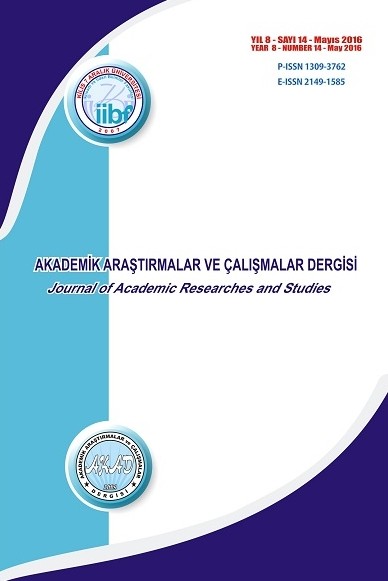Finansal Piyasaların Türkiye’nin Ekonomik Büyümesindeki Rolü
Amaç: Araştırmanın amacı Türkiye’deki bankacılık sektörünün ve hisse senedi piyasasının ekonomik büyüme ile olan ilişkisinin ekonometrik olarak analizidir. Tasarım/Yöntem: Araştırma modelinde, toplam ticari banka kredileri ve hisse senedi piyasasının toplam kapitalizasyonunun ekonomik büyüme ile olan ilişkisi incelenmiştir. Eşbütünleşme testi ve vektör hata düzeltme modeli (VECM) sonrası uygulanan Granger nedensellik testi ile nedenselliğin yönü belirlenmiştir. Bulgular: Çalışmanın bulgularında, gerek öngörülere uygun sonuçlar gerekse öngörülerden ayrılan sonuçlara rastlanmıştır. Toplam ticari banka kredilerinden ekonomik büyümeye doğru istatistiksel olarak anlamlı bir nedensellik belirlenmiştir. Fakat hisse senedi piyasasının toplam kapitalizasyonundan ekonomik büyümeye doğru anlamlı bir nedensellik ilişkisine rastlanmamıştır. Sınırlılıklar: Kullanılan veri setinin sadece iki değişken ve Türkiye üzerine olması araştırmanın sınırlılıklarıdır. Özgünlük/Değer: 2008’de başlayan küresel kriz sonrası Türkiye ekonomisindeki büyümenin şekillenmesinde bankacılık ve hisse senedi piyasanın oynadığı rolün karşılaştırmalı olarak incelenmesi çalışmaya özgünlük katmaktadır. Ayrıca, ulaşılan bulguların ekonomi yönetimi ve politika yapıcılara yön gösterecek nitelikte olduğu düşünülmektedir.
Anahtar Kelimeler:
Bankacılık, Hisse Senedi Piyasası, Ekonomik Büyüme
The Role of Financial Markets in Turkey’s Economic Growth
Purpose: The purpose of the study is to provide an econometric analysis of the relationship among Turkey’s economic growth, stock market and banking. Design/Methodology: In the model, economic growth’s relationships with both total stock market capitalization and total bank commercial credits are examined. Following a co-integration test and a vector error correction model (VECM), the direction of causality is identified via Granger causality test. Findings: The findings include results of which some are in line with predictions while some are not. A statistically significant causality relationship is identified from total bank commercial credits towards economic growth. However, there is not a statistically significant causality relationship from stock market total capitalization towards economic growth. Limitations: The use of a two-variable data set that is on Turkey only constitutes the limitation of the study. Originality/Value: The investigation of the comperative roles of the banking and stock market that they played in shaping Turkey’s economic growth after the global crisis of 2008 constitutes the original value of the research. Moreover, it is considered that the findings are in the quality of proving the economic management and policymakers with useful insights.
Keywords:
Banking, Stock Market, Economic Growth,
___
- Bekaert, G., Harvey, C.R. & Lundblad, C. (2005). Does financial liberalization spur growth? Journal of Financial Economics 77, pp.3–55.
- Cetorelli, N. & Gambera, M. (2001). Banking market structure, financial dependence and growth: International evidence from industry data. Journal of Finance 56(2), pp.617-648.
- Chandavarkar, A. (1992). Of finance and development: Neglected and unsettled questions. World Development 20(1), pp.133–42.
- Cole, R., Moshirian, F. & Wu, Q. (2007). Bank stock returns and economic growth. Munich Personal RePEc Archive 4714.
- Edwards, S., Biscarri, J.G. & de Gracia, F.P. (2003). Stock market cycles, financial liberalization and volatility. Facultad de Ciencias Económicas y Empresariales Universidad de Navara Working Paper 08/03.
- Fama, E.F. (1981). Stock returns, real activity, inflation and Money. American Economic Review 71, pp.545-65.
- Fama, E.F. (1990). Stock returns, expected returns, and real activity. Journal of Finance 45. pp.1089-1108.
- Hartmann, P., Heider, F., Papaioannou, E. & LoDuca, M. (2007). The role of financial markets and innovation in productivity and growth in Europe. European Central Bank Occasional Paper Series 72.
- Hicks, J. (1969). A Theory of Economic History. Clarendon Press, Oxford.
- King, R.G. & Levine, R. (1993). Financial intermediation and economic development. Ed.: Colin Mayer & Xavier Vives, Financial intermediation in the construction of Europe. London: Centre for Economic Policy Research, pp.156–189.
- Krugman, P. (2000). The return of depression economics. Norton, New York.
- La Porta, R., de Silanes, F.L. & Shleifer, A. (2002). Government ownership of banks. Journal of Finance 57(1), pp.265-301.
- Levine, R. (1997). Financial development and economic growth: Views and agenda. Journal of Economic Literature 35(2), pp.688-726.
- Lucas, R.E.Jr. (1988). On the mechanics of economic development. Journal of Monetary Economics 22(1), pp.3–42.
- Robinson, J. (1952). The Generalisation of the General Theory, in the Rate of Interest, and Other Essays. 2nd Edition, Macmillan, London.
- Schumpeter, J.A. (1912). The Theory of Economic Development, Tenth printing 2004, Transaction Publishers, New Brunswick, New Jersey.
- Schwert, W. (1990). Stock returns and real activity: A century of evidence. Journal of Finance 45, pp.1237-1257.
- Stern, N. (1989). The economics of development: A survey. Economics Journal 99(397), pp.597–685.
- Stiglitz, J.E. (2002). Globalization and its discontents. Norton, New York.
- ISSN: 1309-3762
- Yayın Aralığı: Yılda 2 Sayı
- Başlangıç: 2009
- Yayıncı: Kilis 7 Aralık Üniversitesi
Sayıdaki Diğer Makaleler
Finansal Piyasaların Türkiye’nin Ekonomik Büyümesindeki Rolü
Merve Suna ÖZEL ÖZCAN, Lütfi TUTUŞ
Entelektüel Sermaye ile Rekabet Avantajı Arasındaki İlişki: Bir Meta-Analiz Çalışması
Sendikacılıkla Parlamentarizm Arasında Birinci TİP'in Uzun On Yılı (1961-1971)
Kişilik ve Whistleblowing İlişkisi: A ve B Kişilik Tiplerine Göre İhbarcılık Niyet ve Nedenleri
İrem KILIÇ, Emin KUZKAYA, Eymen GÜREL
Özgül BİLİCİ, Elif KARAAHMETOĞLU
Gelişmekte Olan Ülkelerde Okul Öncesi Eğitim ve Ekonomik Büyüme Arasındaki İlişkinin Test Edilmesi
Sinem EYÜBOĞLU, Simge YILMAZ UYSAL
Proje Yönetiminde Yapay Zeka: Bankacılık Sektöründe Bir Uygulama
